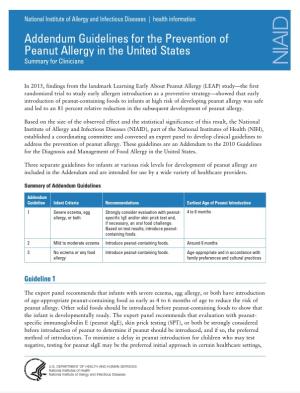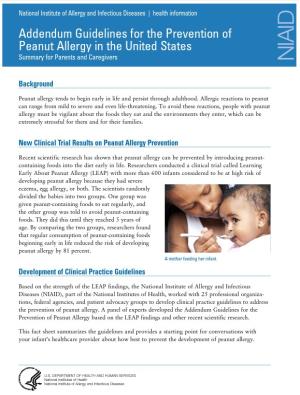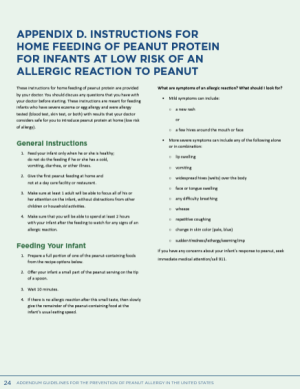In 2008, NIAID established a coordinating committee composed of professional organizations, federal agencies, and patient advocacy groups to oversee development of concise clinical guidelines on the diagnosis and management of food allergy and the treatment of acute food allergy reactions. Developed over two years, the 2010 Guidelines for the Diagnosis and Management of Food Allergy in the United States offer evidence-based recommendations for health care professionals.
In 2015, findings from a landmark NIAID-funded clinical trial called the Learning Early About Peanut (LEAP) study showed that introducing peanut-containing foods to infants at high risk for developing peanut allergy was safe and led to an 81 percent relative reduction in the subsequent development of peanut allergy. Based on the strength of these results, NIAID established another coordinating committee, which convened an expert panel to update the 2010 Guidelines to specifically address the prevention of peanut allergy. The Addendum Guidelines for the Prevention of Peanut Allergy in the United States were published in January 2017.
2017 Addendum Guidelines for the Prevention of Peanut Allergy in the United States

View the Addendum Guidelines for the Prevention of Peanut Allergy in the United States: Report of the NIAID-sponsored Expert Panel

View the Addendum Guidelines for the Prevention of Peanut Allergy in the United States: Summary for Clinicians

View the Addendum Guidelines for the Prevention of Peanut Allergy in the United States: Summary for Parents and Caregivers

View the Instructions for Home Feeding of Peanut Protein for Infants at Low Risk of An Allergic Reaction to Peanut
2010 Guidelines for the Diagnosis and Management of Food Allergy in the United States
View the complete Guidelines for the Diagnosis and Management of Food Allergy in the United States: Report of the NIAID-sponsored Expert Panel
View the Guidelines for the Diagnosis and Management of Food Allergy in the United States: Summary of the NIAID-sponsored Expert Panel Report
View the Guidelines for the Diagnosis and Management of Food Allergy in the United States: Summary for Patients, Families, and Caregivers
Literature Review
Read or download a copy of the independent, systematic literature review which was used in conjunction with consensus expert opinion to develop the guidelines: Prevalence, Natural History, Diagnosis, and Treatment of Food Allergy: A Systematic Review of the Evidence.
Frequently Asked Questions
See a list of frequently asked questions about the guidelines.


